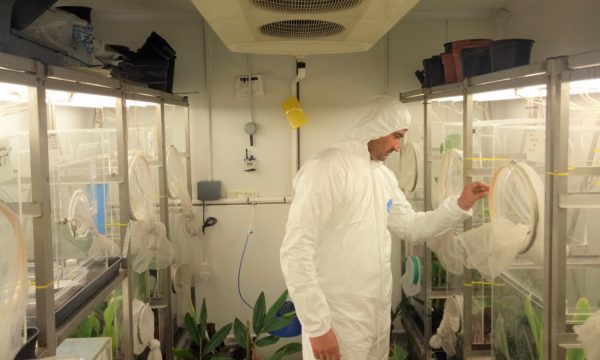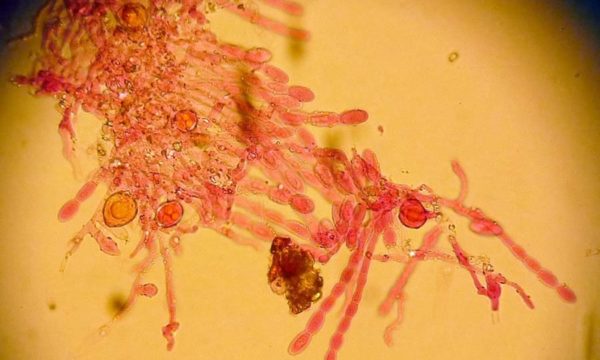
CABI extension workers meet with farmers in Kidoko to advise on how to maximise the benefits of the Fertilizer Optimization Tool
By Dr Monica Kansiime, Scientist Seed Systems, based at CABI in Nairobi, Kenya
A decision support tool that allows an extension agent to take into account a number of the farmers’ circumstances and investment goals to maximize the benefits of fertilizer use on their farms is starting to pay dividends in Molo Sub-County in Uganda – with some farmers reporting a seven-fold increase in yields.
The Fertilizer Optimization Tool (FOT) incorporates the crop’s value, size of land, nutrient requirements of the crops, and the financial resources that the farmer has to invest in fertilizer. The tool also ensures that fertilizer use decisions are made in line with Integrated Soil Fertility Management practices, further ensuring cost-effectiveness for farmers.
Members of the Kidoko post-test club have been speaking in unison about the benefits of FOT after it was introduced by Ali Mawand – a Community Facilitator who works with the NASECO Seed Company.
In addition to his primary job of supporting the groups in accessing quality and elite seed varieties, Mr Mawanda found it prudent to help the farmers sustainably invest in fertilizer use. This included him conducting various training opportunities for the farmers such as showing them practically in the field how the FOT can work for them.
The club is comprised of five farmer groups, each with about 30 members, who meet weekly. As a club they come together as a whole and meet monthly. During their weekly meetings the farmers take advantage of the opportunity to save and borrow money under the popular co-save program known as Village Savings and Loan Associations (VSLA). Ultimately this is aimed at enhancing financial inclusion.
The group also boasts of owning a Village Resource Centre, that doubles as an agro-input shop. Essentially, this is a one-stop centre for farmers to seek information and obtain inputs. The main crops grown by the group members are; maize, soy bean, rice (upland), and horticulture crops. The farmers have indicated that the FOT is economical and has helped farmers with small resources to invest in fertilizer and improve their productivity.

A Village Resource Centre which doubles as an agro-input shop
Martin Omela, a group member and resident of Kidoko village, said, “Our soils are currently depleted requiring fertilization. However, due to low incomes, most of us have not used fertiliser – though we know the benefits.
“When I was introduced to the Fertilizer Optimization Tool by Mr Mawanda, I only had UGX 50,000 (approx. $13). I told him I cannot use fertilizer because I don’t have enough money to buy even one bag of fertiliser. One 50kg bag, alone, is sold at UGX150,000 (approx. $40).
“He explained that the tool helps to calculate only the fertiliser I need given the amount to invest. The output showed that I needed to buy 10kg of DAP, and 10kg Urea for my ½ acre of maize. I applied the DAP, one bottle top per hole and Urea in bands. As a result, I harvested 700kg compared to 100kg before (or even sometimes less) from the same area.”
For farmers who used fertilizer before, their appraisal of the tool was based on its ability to recommend only what is required, therefore, avoiding wastage of fertilizers. The common practice for those using fertilizer has been to procure 50kg of fertilizer, commonly, DAP, Urea or TSP and applying according to their own knowledge. This practice, farmers have realised, has a high investment cost attached to it – yet this cost is not necessarily offset by the added production.
Okingok Paul, group chairman, said, “I have used fertilizer for five years because of the high yields obtained. My usual practice was to buy 50kg bags each of DAP, Urea and TSP to apply in maize and groundnuts. Each season I would spend about UGX 450,000 (approx. $121) on fertilizers. Much as the yield was good thought it was not a sufficient return on my investment in fertilizer.
“Last season, Last season, Mr Mawanda taught us about fertilizer optimisation and for my 2 ½ acres of maize, ground nuts and soybeans, I bought 22kg DAP, 11kg Urea and 11kg TSP at a cost of UGX100,000. The yields were significantly higher than before. At less than 1/3 of the investment, I got 16 bags of maize compared to 10 bags the previous season.
“I think we have been wasting fertilizer and money in using a blanket application. I will continue using the technology and look forward to the mobile application which we can even do ourselves.”
Other members in the group had similar experiences utilising the FOT. The only challenge they mentioned was the need to invest more in labour due to the tedious application methods – for example, banding compared to broadcasting, which is their usual method. The farmers also acknowledged that the application method is economical as one applies fertilizer only where needed.
Using the platform of the resource centre, the group leader indicated that they will continue to encourage other members to try out the tool for better yields.
Additional information
Fertilizer Optimization Tool
Find out more about the Fertilizer Optimization Tool.
Related stories
Read how the fertilizer approach could empower 50 million African families as a result of using the Fertilizer Optimization Tool.
Watch the YouTube video below about the net financial returns to fertilizer use underpinning a Fertilizer Optimizer Tool
https://youtu.be/NCu6xdFaDjw
1 Comment
Leave a Reply
Related News & Blogs
Transforming agriculture with drones: empowering youths for a sustainable future
On this UN World Youth Skills Day 2023 (Saturday, 15 July), we celebrate the transformative power of skill development in shaping the lives of young individuals and creating a brighter future, writes Violet Ochieng’ – winner of the Carol Ellison Scienc…
14 July 2023





[…] a previous blog post I outlined how the Fertilizer Optimization Tool (FOT) is paying dividends for farmers – […]